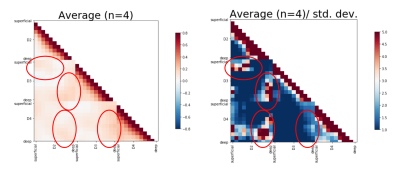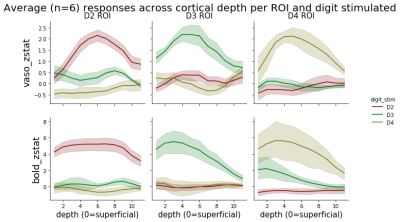Sebastian Dresbach1, Renzo Huber1, Rainer Goebel1, and Amanda Kaas1
1Cognitive Neuroscience, Faculty of Psychology and Neuroscience, Maastricht University, Maastricht, Netherlands
1Cognitive Neuroscience, Faculty of Psychology and Neuroscience, Maastricht University, Maastricht, Netherlands
Using VASO, we identified individual digit-representations in humans and found depth-dependent intrinsic interactions between deep layers of digit-representations at rest.

Layer to layer correlations across ROIs. Left: Average connectivity matrix across 4 subjects. Increased correlations are highlighted by red ellipses. Specifically, deep layers of a given digit representation seem to be intrinsically more connected to deep than other layers of other digits' representations. Furthermore, superficial layers of D2 and D3 show a similar pattern.
Right: In order to investigate the stability of these findings, we divided the average matrix by the std. deviation across subjects. Crucially, regions of higher correlations also show highest stability.

Average z-statistic (contrast: digit vs. rest) per cortical depth for each ROI and modality across all subjects and runs (upper row: VASO, lower row: BOLD). Lowest cortical depth refers to pial surface. In ROIs corresponding to the stimulated digit, profiles show a peak in middle layers for VASO and a peak drawn towards the lower cortical depth for BOLD-signal. Peaks in middle cortical depth during stimulation likely indicate inout from the thalamus which is detectable with VASO due to higher specificity. Note the higher sensitivity of BOLD, illustrated by higher z-values. Shade=95% CI